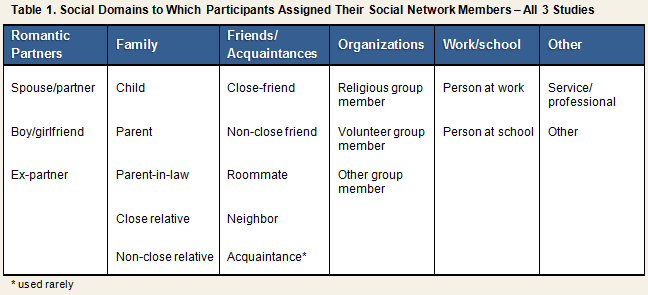Primary References
Reis, H. T., & Wheeler, L. (1991). Studying social interaction with the Rochester Interaction Record. Advances in Experimental Social Psychology, 24, 269–318.
Cohen, S., Doyle, W. J., Turner, R. B., Alper, C. M., & Skoner, D. P. (2003). Sociability and susceptibility to the common cold. Psychological Science, 14, 389-395.
Purpose
To assess daily social interactions over a 2-week period.
Description
Participants were interviewed by telephone on 3 evenings per week for 2 weeks. Included in the interviews was a review of interpersonal interactions that was modeled after the Rochester Interaction Record (Reis & Wheeler, 1991) and that focused on all interactions that participants had engaged in over the course of the day. For the purposes of the interview, an interaction was defined as spending time with one or more persons for 10 consecutive minutes or longer. For each one-on-one or group interaction, participants provided the following information:
- with whom the participant interacted
- when the interaction started and ended
- who initiated the interaction
- whether the participant gave or received support during the interaction
- pleasantness of the interaction
- whether and to what extent the interaction involved disagreement or conflict
Interview social interaction items and response options are presented in Table 2 (see also PCS2 Daily Interview Form).
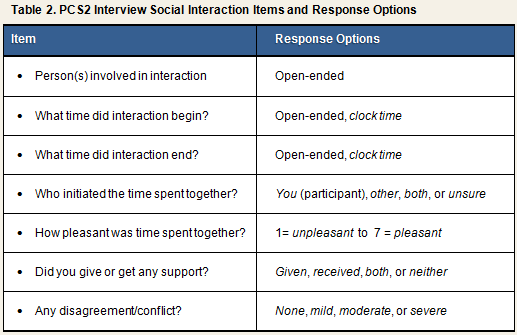
Number of Items
8 items for each social interaction
Variables/Scoring
PCS2 shares several interview social interaction variables in common with PMBC and PCS3. These will be described in a later section (see Common Social Interaction Variables Derived from Daily Interview Items). Table 3 presents a list of social interaction variables that are specific to PCS2. These variables were computed for each interview day, as well as aggregated across days by averaging or summing daily values across the entire interview period.
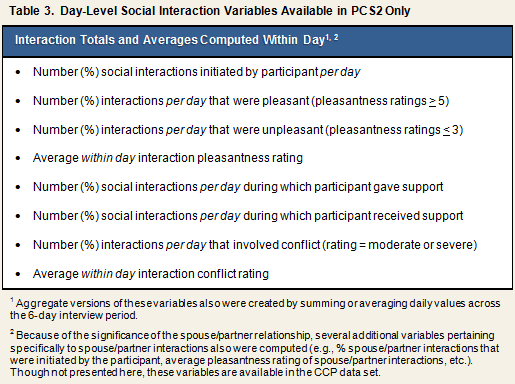
Psychometrics
Not available
|
Primary Reference
Purpose
To assess daily interactions and activities over a 2-week period.
Description
Participants were interviewed by telephone at approximately the same time on each of 14 consecutive evenings. During each interview, participants answered questions regarding activities in which they might have engaged with one or more other persons during the course of the preceding 24 hours. Participants were asked specifically about the five defined categories of activities listed below.
- Meal, drink, snack, coffee, etc.
- Leisure activities at home
- Leisure activities away from home
- Work around the house
- Family or personal errands away from home
In the event that a participant engaged in an activity that could not be classified as belonging to one of the above categories, the option was available for the interviewer to add up to 2 supplementary activity categories (see also PMBC and PCS3 Interview Forms). For each activity, participants were asked to report on what it was that they did (e.g., ate breakfast, went on a bike ride); who engaged in this activity with them; and how long they were engaged in that activity. From these data, several variables were computed for each social activity category (see Table 4). Because it was possible for participants to engage in more than one instance of a given social activity category during the course of a single day, totals were computed both within day and across days. The Common Cold Project (CCP) data set also includes variables representing the total number of different categories of social activity engaged in each day as well as the total number engaged in across the interview period. (For additional information on daily social activity data collected in PCS3, see the description of the Daily Social Rhythm Metric).
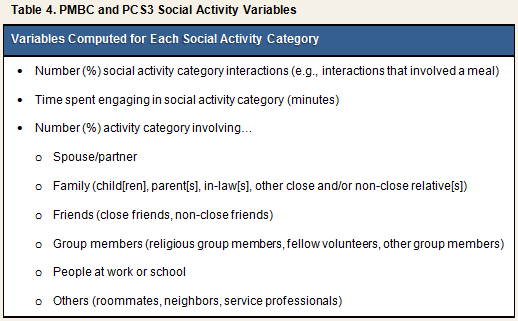
In addition to asking participants about specific activities they engaged in with other persons, interviewers also inquired about whether participants had in the past 24 hours
- spent romantic time with another person (in PMBC, married/partnered persons were asked specifically about their spouse/partner);
- were involved in any tension or disagreement with another person; or
- told someone about the best thing that happened to them that day (PCS3 only).
Participants also were asked whether they had been hugged during the preceding day. When participants reported experiencing a disagreement or social conflict, the interviewer followed up on the conflict during the next interview by asking whether the participant had thought about the conflict during the past 24 hours (yes / no) and the extent to which he or she was bothered by the conflict (response options: 0 = not at all bothersome to 4 = extremely bothersome).
Quality of social interactions. The PMBC interview also included a set of questions pertaining to the quality of supportive interactions and interpersonal conflicts. Married/partnered persons were asked these questions specifically in regard to their spouse/partner as well as in regard to other persons. Interaction quality items and response options are presented in Table 5.
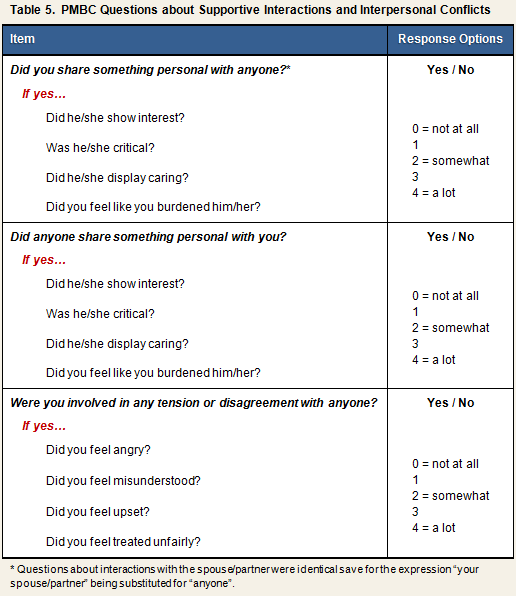
Received support, given support, and tension/disagreement scores were computed for each day by summing the values of the 4 related follow-up items. For married/partnered persons, an additional set of three scores was computed for interactions involving the spouse/partner.
Psychometrics
Not available
|
Common Social Interaction Variables Derived from Daily Interviews: PCS2, PMBC, PCS3
The following set of tables displays created social interaction variables that have been derived from the daily interview data collected in PCS2, PMBC, and PCS3. Table 6 displays day-level interaction variables that are common to all three studies.
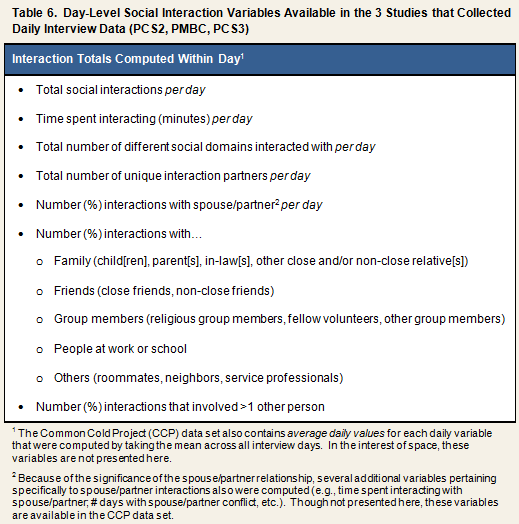
Average daily scores for each of the variables displayed in Table 5 were computed by taking the mean of the day-level values across all interview days. Although these averaged variables are not presented here, they are included in the Common Cold Project (CCP) data set.
By comparison, Table 7 displays two types of aggregate variables that were derived by taking the sum of values across interview days. The first set of variables (Total Interactions) represents the total number of different types of social interactions computed across interview days, whereas the second set of variables (Total Days) represents the total number of interview days on which a certain type of interaction occurred.
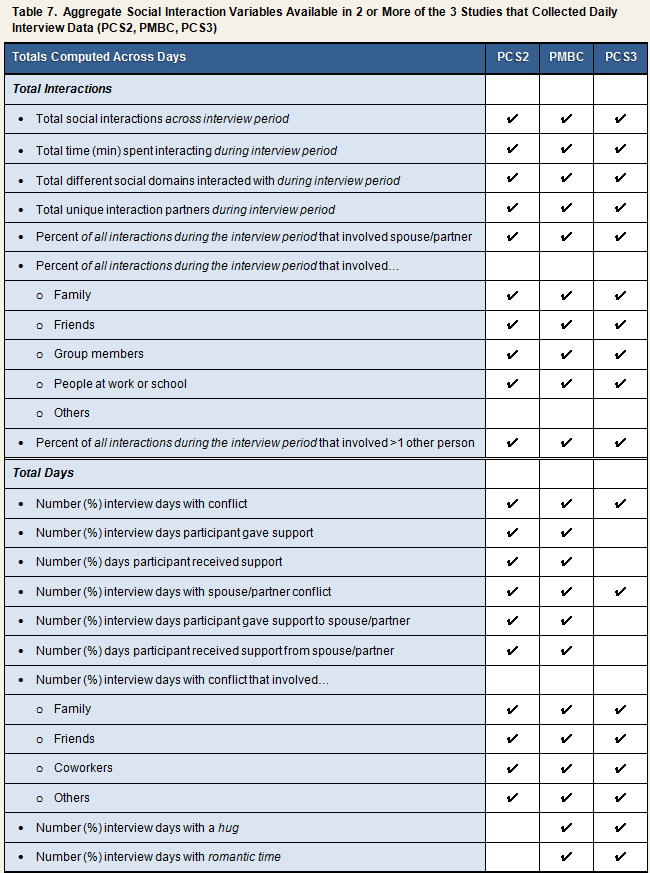
Also available in PCS3, in addition to the variables described in Table 7, is the number of days during which the participant told someone about the best thing that happened to him or her that day. For each day that the participant reported sharing the best thing that happened, also available is whether the participant shared with his or her spouse/partner, child(ren), parent(s), friend(s), coworker(s), other relative(s), or someone else.
|
